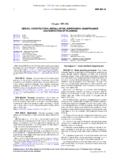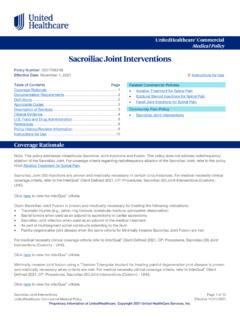Transcription of Communication to Horizon 2020 beneficiaries How to avoid ...
1 1 Communication to Horizon 2020 beneficiaries How to avoid errors when claiming costs in H2020 grants 1. INTRODUCTION It is in the interests of beneficiaries and the Commission that there are as few errors as possible when claiming costs. A low error rate: strengthens the reputation of Horizon 2020 means continued taxpayer support for science and innovation funding speeds up payments lessens the administrative burden by preventing having to recover amounts unduly paid. With this in mind, we want to share the main findings, so far, of the ex-post audits on H2020 grants. We have listed the most common errors along with some explanations. Please bear them in mind when claiming costs. The annotated model grant agreement contains detailed guidance, including examples and specific cases. The answers to the frequently asked questions are also published on the Funding & Tenders Portal. The Research Enquiry Service can also help you. 2. MOST COMMON ERRORS IN H2020 The Annex contains an overview of the results of H2020 audits available as of January 2022, corresponding to approximately 41 % of the audits planned for H2020.
2 It provides details on the percentage of main errors, per budget category, which lead to adjustments in favour of the EU budget. The most common errors made by audited beneficiaries are as follows: Personnel costs 2 - incorrect calculation of productive hours - incorrect remuneration costs: budgeted, standard, estimated or fixed rates - invalid or missing timesheets or supporting documents - incorrect time claimed Other goods and services no valid supporting documents Subcontracting costs - no valid supporting documents - no value for money Equipment - errors in equipment costs due to no direct measurement of the costs Travel - no valid supporting documents - costs not related to the action 3. HOW TO avoid THE MOST COMMON ERRORS Keeping records of personnel costs and incorrect time claimed - As a general rule, you must keep timesheets that comply with the minimum requirements stipulated in the H2020 grant agreement. If you do not have a model timesheet of your own, you can find an example prepared by the Commission here.
3 - You should ensure that the total number of hours declared in EU and EURATOM grants for a person for a year is not higher than the number of annual productive hours used to calculate the hourly rate. The total amount of personnel costs declared in these grants for a person for a year must also not be higher than the total personnel costs recorded in your accounts (double ceiling). - You should only claim hours actually worked on the project. As such, information included in timesheets must match records of annual leave, sick leave, other types of leave and work-related travel. You also cannot claim hours during absences (such as annual leave or sick leave). Calculation of productive hours - To calculate productive hours, you must use one of the three options provided for in the H2020 model grant agreement: fixed number of hours (1 720), individual annual productive hours or standard annual productive hours.
4 However, you can use different options for different types of personnel provided that the same option is applied consistently to each personnel group employed under similar conditions ( same staff category or same type of contract). 3 - You must use the same option(s) for the full financial year. - For hourly rates calculated on a monthly basis, you cannot use option 2 (individual annual productive hours). - If in doubt, use option 1 (1 720 productive hours) you do not need to document it and the auditors will not challenge it. Ineligible remuneration costs - Ensure that remuneration is in line with your usual practice ( you should not use budgeted, standard, estimated or fixed rates for calculating remuneration costs). - Remuneration must be supported by evidence ( payroll, salary slips, employment contracts). - Remuneration should be paid in accordance with national law, the collective labour agreement and the employment contract (or equivalent appointment act).
5 Claiming costs related to the action - You should make sure that you can demonstrate a link to the H2020 action ( travel for which costs are claimed must be necessary for the action). - If it is normal practice for you to consider certain costs as indirect costs, you cannot declare them as direct costs. Ensuring all costs are properly documented - Costs claimed must be identifiable and verifiable. This means that they must be reconcilable with your accounts and supported by documentation. - The acquisition of goods and services (subcontracting or other direct costs) should comply with the best value for money principle. To demonstrate best value for money, you must also document that the internal procedure was followed or that the subcontracted tasks were carried out. No direct measurement of costs - You should ensure that goods and services ( consumables) charged as direct costs to the project are measured accurately and charged at cost basis. This implies that goods or services are not charged to the action using an apportionment method (approximation, distribution keys, etc.)
6 - In the absence of direct measurement, you cannot claim costs as direct costs. Such costs are considered as indirect costs, which are calculated using the 25 % flat rate in H2020. 4 ANNEX OVERVIEW OF INITIAL RESULTS OF H2020 AUDITS (figures refer to audits on actions declaring actual costs until October 2021) 68%14%10%4%2%1%1%0%Percentage of errors identified in H2020 ex-post audits leading to adjustments in favour of the EU budgetPersonnelOther goods & servicesSubcontractingEquipmentTravelLar ge research infrastructureInstitutional costsReceipts18,19%11,78%11,71%11,24%9,1 7%3,90%1,78%0,00%2,00%4,00%6,00%8,00%10, 00%12,00%14,00%16,00%18,00%20,00%Incorre ctproductive hourscalculationIncorrectremuneration(bu dgeted,estimates)Other errorsinvalid/notimesheets orsupportingdocumentsIncorrect timeclaimedDoublecharging/funding,or indirect claimedas directNot foreseen inAnnex I nor agreedby EU services, ornot related to theactionPercentage of type of error in personnel costs 5 18,19%11,78%11,71%11,24%9,17%3,90%1,78%9 ,61%4,16%5,77%3,25%3,02%1,30%1,96%0,00%5 ,00%10,00%15,00%20,00%Personnel - Incorrect productive hours calculationPersonnel - Incorrect remuneration (budgeted, estimates)Personnel - Other errorsPersonnel - invalid/no timesheets or supporting documentsPersonnel - Incorrect time claimedPersonnel - Double charging/funding, or indirect claimed as directPersonnel - Not foreseen in Annex I nor agreed by EU Services, ornot related to actionSubcontractingEquipmentOther goods & services - no valid supporting documents (otherthan timesheets for personnel)
7 Other goods & services - no direct measurement, no best valuefor money, double charging/fundingOther goods & services - other errorsOther goods & services - costs not related to the actionTravelBreakdown of all errors identified in H2020 audits in favour of the EU budget 6 1. Personnel costs Personnel costs are the largest type of costs claimed and reimbursed under H2020. Most of the errors identified in audits involve personnel costs, with a total of 67,78 % of all errors leading to adjustments in favour of the EU budget. This breaks down as follows: 18,19 % were due to the incorrect calculation of productive hours 11,78 % were due to incorrect remuneration costs for both actual personnel costs and average costs for personnel (for example: budgeted costs or estimates were claimed rather than actual costs) 11,24 % were due to invalid/no timesheets or supporting documents 9,17 % were due to incorrect time claimed working on the action 3,90 % were due to double charging, double funding, or indirect costs claimed as direct costs 1,78 % were not foreseen in Annex I nor agreed by EU Services or not related to the action 11,71 % were due to other reasons 2.
8 Other goods and services 13,99% of all errors identified in financial audits are due to mistakes in declaring other goods and services. This is for the most part due to a lack of adequate supporting documents (5,77 %) or no direct measurement of costs, no best value for money, double charging/funding (3,25 %). 3. direct costs of subcontracting Of all the errors identified under subcontracting (9,61 %), the majority (7,50 %) were due to a lack of adequate supporting documents or no best value for money. 4. Equipment costs Errors in equipment costs (4,16 % of all errors) are mainly due to no direct measurement of the costs. 5. Travel costs 1,96 % of all errors were found in travel cost declarations. The findings mainly pointed to the fact that there was a lack of supporting documents to justify the costs (0,73 %), or that the costs claimed were not related to the action (0,58 %).














